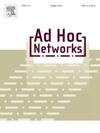WISDOM: A framework for scaling on-device Wi-Fi sensing solutions
IF 4.8
3区 计算机科学
Q1 COMPUTER SCIENCE, INFORMATION SYSTEMS
引用次数: 0
Abstract
Recent innovations in Wi-Fi sensing capitalizes on a host of powerful deep neural network architectures that make inferences based on minute spatio-temporal dynamics in the wireless channel. Many of such inference techniques being resource intensive, conventional wisdom recommends offloading them to the network Edge for further processing. In this paper, we argue that edge based sensing is often not a viable option for many applications (due to cost, bandwidth, latency etc.). Rather, we explore the paradigm of on-device Wi-Fi sensing where inference is carried out locally on resource constrained IoT platforms. We present extensive benchmark results characterizing the resource consumption (memory, energy) and the performance (accuracy, inference rate) of some typical sensing tasks. We propose WISDOM, a framework that, depending on capabilities of the hardware platform and application’s requirements, can compress the inference model. Such context aware compression aims to improve the overall utility of the system — maximal inference performance at minimal resource costs. We demonstrate that models obtained using the WISDOM framework achieve higher utility compared to baseline models that are just quantized for 83% of the cases. While for non-compressed models it has higher utility 99% of the time.
WISDOM:用于扩展设备上Wi-Fi传感解决方案的框架
Wi-Fi传感的最新创新利用了大量强大的深度神经网络架构,这些架构基于无线信道中的微小时空动态进行推断。许多这样的推理技术都是资源密集型的,传统智慧建议将它们卸载到网络边缘以进行进一步处理。在本文中,我们认为基于边缘的传感通常不是许多应用的可行选择(由于成本,带宽,延迟等)。相反,我们探索了设备上Wi-Fi传感的范例,其中推理是在资源受限的物联网平台上进行的。我们提供了广泛的基准测试结果,表征了一些典型传感任务的资源消耗(内存,能量)和性能(准确性,推理率)。我们提出了一个基于硬件平台能力和应用需求压缩推理模型的框架WISDOM。这种上下文感知压缩旨在提高系统的整体效用——以最小的资源成本获得最大的推理性能。我们证明,与基线模型相比,使用WISDOM框架获得的模型实现了更高的效用,基线模型仅对83%的情况进行了量化。而对于非压缩模型,它在99%的情况下具有更高的效用。
本文章由计算机程序翻译,如有差异,请以英文原文为准。
求助全文
约1分钟内获得全文
求助全文
来源期刊

Ad Hoc Networks
工程技术-电信学
CiteScore
10.20
自引率
4.20%
发文量
131
审稿时长
4.8 months
期刊介绍:
The Ad Hoc Networks is an international and archival journal providing a publication vehicle for complete coverage of all topics of interest to those involved in ad hoc and sensor networking areas. The Ad Hoc Networks considers original, high quality and unpublished contributions addressing all aspects of ad hoc and sensor networks. Specific areas of interest include, but are not limited to:
Mobile and Wireless Ad Hoc Networks
Sensor Networks
Wireless Local and Personal Area Networks
Home Networks
Ad Hoc Networks of Autonomous Intelligent Systems
Novel Architectures for Ad Hoc and Sensor Networks
Self-organizing Network Architectures and Protocols
Transport Layer Protocols
Routing protocols (unicast, multicast, geocast, etc.)
Media Access Control Techniques
Error Control Schemes
Power-Aware, Low-Power and Energy-Efficient Designs
Synchronization and Scheduling Issues
Mobility Management
Mobility-Tolerant Communication Protocols
Location Tracking and Location-based Services
Resource and Information Management
Security and Fault-Tolerance Issues
Hardware and Software Platforms, Systems, and Testbeds
Experimental and Prototype Results
Quality-of-Service Issues
Cross-Layer Interactions
Scalability Issues
Performance Analysis and Simulation of Protocols.
 求助内容:
求助内容: 应助结果提醒方式:
应助结果提醒方式:


